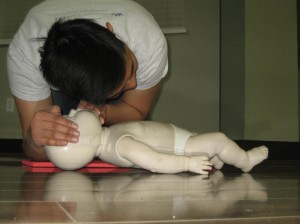
When you train in a cardiopulmonary resuscitation class, you have to choose between basic and advanced training. The Basic Life Support category covers the three basic CPR skills: compressions, rescue breaths, and defibrillation. Advanced courses belong to the Advanced Life Support category, programs that cover medical management of cardiac arrest. We have two ALS programs available: ACLS (Advanced Cardiac Life Support) and PALS (Pediatric Advanced Life Support). Registration for any workplace or academic approved course can be completed here.
What can I learn in an ALS class? Is it different from BLS training?
Basic Life Support programs teach students about the basics of resuscitation, primarily focused on skill building. Trainees are taught how to keep a victim stable before the arrival of medical help, and in a worst case scenario, the rescuer can perform hands-only CPR (without ventilation). However, in an Advanced Life Support class, the rescuer learns about medical management – this is involves medication, advanced airways, and ECGs to stabilize a victim cardiac arrest.
What is asphyxial arrest?
When children, especially very young children like infants, experience cardiac arrest, the cause is usually respiratory in nature. When arrest happens to adults, it is usually because of a pre-existing cardiac problem. Respiratory failure can cause increased stress to the heart and it can stop beating – a condition that is called asphyxial arrest. Respiratory failure in children usually leads to asphyxial arrest.
Giving PALS
PALS and ACLS are usually given through an organized response system in an advanced medical environment. There are typically mutiple responders, either the healthcare providers on shift or the code team. The word code is used to describe a case of cardiac arrest that requires immediate management.
Shock
Shock is a result of poor blood flow and oxygen delivery to the tissues. When the tissues don’t receive enough oxygen, they cannot meet the body’s metabolic demands and the tissues begin to die. In children, the most common kind of shock is hypovolemic – or shcok resulting from a loss of fluid, usually blood (hemorrhage). Other kinds of shock like distributive and cardiogenic shock happen less frequently to children.
Once a person experiences shock, the body tries to compensate by increasing the heart beat (tachycardia) and systemic vascular resistance (vasoconstriction). When these methods fail to get the person’s condition stable, decompensatory mechanisms start to happen, resulting in hypotensive shock.
When compensatory mechanisms are in effect, rescuers are taught to expect:
- Tachycardia (pulse > 100)
- Cool and pale extremities
- Prolonged capillary refill (>2 seconds)
- Weak peripheral pulses
- Norma blood pressure (systolic)
When these mechanisms fail, the following signs and symptoms can be observed:
- Decreasing level of consciousness
- Decreased urine output
- Metabolic acidosis
- Tachypnea (respirator rate > 22)
- Weak central pulses (carotid, femoral, apical)
The PALS program is 14 hours long in total, and takes two days to complete. It’s accompanying re-certification class is either 6 hours and 20 minutes or 8 hours and 20 minutes. The certificate that we award students with is only valid for two years then it expires. However, it can be renewed through re-certification classes.